Rob Mclennan's Blog, page 57
April 9, 2024
Touch the Donkey : new interviews with Michael Harman, Terri Witek and Laynie Browne,
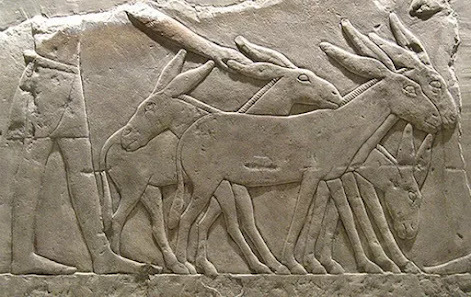 Anticipating the release next week of the TENTH ANNIVERSARY forty-first issue of Touch the Donkey [a small poetry journal], why not check out the interviews that have appeared over the past few weeks with contributors to the fortieth issue: Michael Harman, Terri Witek and Laynie Browne.
Anticipating the release next week of the TENTH ANNIVERSARY forty-first issue of Touch the Donkey [a small poetry journal], why not check out the interviews that have appeared over the past few weeks with contributors to the fortieth issue: Michael Harman, Terri Witek and Laynie Browne.Interviews with contributors to the first thirty-nine issues (more than two hundred and fifty interviews to date) remain online, including: Noah Berlatsky, Robyn Schelenz, Andy Weaver, Dessa Bayrock, Anselm Berrigan, Alana Solin, Michael Betancourt, Monty Reid, Heather Cadsby, R Kolewe, Samuel Amadon, Meghan Kemp-Gee, Miranda Mellis, kevin mcpherson eckhoff and Kimberley Dyck, Junie Désil, Micah Ballard, Devon Rae, Barbara Tomash, Ben Meyerson, Pam Brown, Shane Kowalski, Kathy Lou Schultz, Hilary Clark, Ted Byrne, Garrett Caples, Brenda Coultas, Sheila Murphy, Chris Turnbull and Elee Kraljii Gardiner, Stuart Ross, Leah Sandals, Tamara Best, Nathan Austin, Jade Wallace, Monica Mody, Barry McKinnon, Katie Naughton, Cecilia Stuart, Benjamin Niespodziany, Jérôme Melançon, Margo LaPierre, Sarah Pinder, Genevieve Kaplan, Maw Shein Win, Carrie Hunter, Lillian Nećakov, Nate Logan, Hugh Thomas, Emily Brandt, David Buuck, Jessi MacEachern, Sue Bracken, Melissa Eleftherion, Valerie Witte, Brandon Brown, Yoyo Comay, Stephen Brockwell, Jack Jung, Amanda Auerbach, IAN MARTIN, Paige Carabello, Emma Tilley, Dana Teen Lomax, Cat Tyc, Michael Turner, Sarah Alcaide-Escue, Colby Clair Stolson, Tom Prime, Bill Carty, Christina Vega-Westhoff, Robert Hogg, Simina Banu, MLA Chernoff, Geoffrey Olsen, Douglas Barbour, Hamish Ballantyne, JoAnna Novak, Allyson Paty, Lisa Fishman, Kate Feld, Isabel Sobral Campos, Jay MillAr, Lisa Samuels, Prathna Lor, George Bowering, natalie hanna, Jill Magi, Amelia Does, Orchid Tierney, katie o’brien, Lily Brown, Tessa Bolsover, émilie kneifel, Hasan Namir, Khashayar Mohammadi, Naomi Cohn, Tom Snarsky, Guy Birchard, Mark Cunningham, Lydia Unsworth, Zane Koss, Nicole Raziya Fong, Ben Robinson, Asher Ghaffar, Clara Daneri, Ava Hofmann, Robert R. Thurman, Alyse Knorr, Denise Newman, Shelly Harder, Franco Cortese, Dale Tracy, Biswamit Dwibedy, Emily Izsak, Aja Couchois Duncan, José Felipe Alvergue, Conyer Clayton, Roxanna Bennett, Julia Drescher, Michael Cavuto, Michael Sikkema, Bronwen Tate, Emilia Nielsen, Hailey Higdon, Trish Salah, Adam Strauss, Katy Lederer, Taryn Hubbard, Michael Boughn, David Dowker, Marie Larson, Lauren Haldeman, Kate Siklosi, robert majzels, Michael Robins, Rae Armantrout, Stephanie Strickland, Ken Hunt, Rob Manery, Ryan Eckes, Stephen Cain, Dani Spinosa, Samuel Ace, Howie Good, Rusty Morrison, Allison Cardon, Jon Boisvert, Laura Theobald, Suzanne Wise, Sean Braune, Dale Smith, Valerie Coulton, Phil Hall, Sarah MacDonell, Janet Kaplan, Kyle Flemmer, Julia Polyck-O’Neill, A.M. O’Malley, Catriona Strang, Anthony Etherin, Claire Lacey, Sacha Archer, Michael e. Casteels, Harold Abramowitz, Cindy Savett, Tessy Ward, Christine Stewart, David James Miller, Jonathan Ball, Cody-Rose Clevidence, mwpm, Andrew McEwan, Brynne Rebele-Henry, Joseph Mosconi, Douglas Barbour and Sheila Murphy, Oliver Cusimano, Sue Landers, Marthe Reed, Colin Smith, Nathaniel G. Moore, David Buuck, Kate Greenstreet, Kate Hargreaves, Shazia Hafiz Ramji, Erín Moure, Sarah Swan, Buck Downs, Kemeny Babineau, Ryan Murphy, Norma Cole, Lea Graham, kevin mcpherson eckhoff, Oana Avasilichioaei, Meredith Quartermain, Amanda Earl, Luke Kennard, Shane Rhodes, Renée Sarojini Saklikar, Sarah Cook, François Turcot, Gregory Betts, Eric Schmaltz, Paul Zits, Laura Sims, Stephen Collis, Mary Kasimor, Billy Mavreas, damian lopes, Pete Smith, Sonnet L’Abbé, Katie L. Price, a rawlings, Suzanne Zelazo, Helen Hajnoczky, Kathryn MacLeod, Shannon Maguire, Sarah Mangold, Amish Trivedi, Lola Lemire Tostevin, Aaron Tucker, Kayla Czaga, Jason Christie, Jennifer Kronovet, Jordan Abel, Deborah Poe, Edward Smallfield, ryan fitzpatrick, Elizabeth Robinson, nathan dueck, Paige Taggart, Christine McNair, Stan Rogal, Jessica Smith, Nikki Sheppy, Kirsten Kaschock, Lise Downe, Lisa Jarnot, Chris Turnbull, Gary Barwin, Susan Briante, derek beaulieu, Megan Kaminski, Roland Prevost, Emily Ursuliak, j/j hastain, Catherine Wagner, Susanne Dyckman, Susan Holbrook, Julie Carr, David Peter Clark, Pearl Pirie, Eric Baus, Pattie McCarthy, Camille Martin and Gil McElroy.
The forthcoming forty-first issue features new writing by: rob mclennan, Gil McElroy, ryan fitzpatrick, John Barlow, Amanda Earl, Renée Sarojini Saklikar, Conyer Clayton, Julie Carr and Pattie McCarthy!
And of course, copies of the first thirty-nine issues are still very much available. Why not subscribe? Included, as well, as part of the above/ground press annual subscription! Which you should get right now for 2024!
and don't forget the Touch the Donkey TENTH ANNIVERSARY SALE, available until the end of April!
We even have our own Facebook group. It’s remarkably easy.
April 8, 2024
the laurentitudes: eastering in sainte-adèle,
 Aftermonths of seemingly-unable, we finally managed a weekend into Sainte-Adèle,into the Laurentides, where we spent a few days with mother-in-law in her weecottage across the Easter long weekend. I know we’ve been there since, but I seem not to have posted a report since we were there for Thanksgiving in 2022 for some reason. Oh, it was good to get out of the daily for a little bit. We considered heading up on Friday, but didn’t quite make it out (Aoife wasn't feeling well),landing Saturday mid-day, instead. We hadn't realized the temperature difference (there was still snow on the ground, and we could see an array of skiers up in all those hills as we drove in). Christine didn't even bring a coat!
Aftermonths of seemingly-unable, we finally managed a weekend into Sainte-Adèle,into the Laurentides, where we spent a few days with mother-in-law in her weecottage across the Easter long weekend. I know we’ve been there since, but I seem not to have posted a report since we were there for Thanksgiving in 2022 for some reason. Oh, it was good to get out of the daily for a little bit. We considered heading up on Friday, but didn’t quite make it out (Aoife wasn't feeling well),landing Saturday mid-day, instead. We hadn't realized the temperature difference (there was still snow on the ground, and we could see an array of skiers up in all those hills as we drove in). Christine didn't even bring a coat!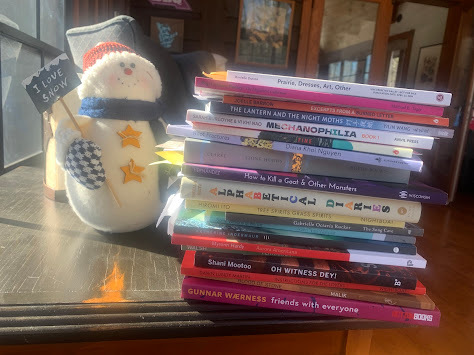 The children played games, played outside, played on their tablets, did quiet things. I focused my attentions on the growing mounds of books over the past couple of months I hadn't even had a chance to open yet, for the sake of potential review. I think I managed to start more than two dozen reviews (and a couple of books I realized I didn't think I would have anything, or enough, constructive to say, so those were set aside). There is simply too much remarkable material being produced these days to be able to account for it all (I know I'm seriously behind on Graywolf Press titles, for example, as well as Copper Canyon and Flood Editions; at least Sylvia Legris' new title from New Directions landed, as I was writing this). I sat in the sunroom and I poured through books (and also made significant headway, I must say, through two short stories I've already been months working on, plus a few other odds and sods of note-taking). Christine, on her part, finished reading the book she'd been going through, and went through two different books on L.M. Montgomery (including the short Penguin biography by Jane Urquhart) for the sake of working a small write-up for an exhibition on and around her works.
The children played games, played outside, played on their tablets, did quiet things. I focused my attentions on the growing mounds of books over the past couple of months I hadn't even had a chance to open yet, for the sake of potential review. I think I managed to start more than two dozen reviews (and a couple of books I realized I didn't think I would have anything, or enough, constructive to say, so those were set aside). There is simply too much remarkable material being produced these days to be able to account for it all (I know I'm seriously behind on Graywolf Press titles, for example, as well as Copper Canyon and Flood Editions; at least Sylvia Legris' new title from New Directions landed, as I was writing this). I sat in the sunroom and I poured through books (and also made significant headway, I must say, through two short stories I've already been months working on, plus a few other odds and sods of note-taking). Christine, on her part, finished reading the book she'd been going through, and went through two different books on L.M. Montgomery (including the short Penguin biography by Jane Urquhart) for the sake of working a small write-up for an exhibition on and around her works. There were three daily deer, also. The final morning, they even brought along two friends.
There were three daily deer, also. The final morning, they even brought along two friends.Atone point on Saturday, Christine pointed out she couldn’t find the cat, but thescreen was out of the open second storey window, and we all scoured the houserepeatedly, around the house and even walked down the road with the two youngladies, knocking on doors. Have you seen a black and white cat? A full twohours of stress, completely unaware where he might be, although mother-in-lawand I weren’t quite convinced he was outside. Half an hour later, I madeanother attempt to look upstairs, as he simply strolled out of the upstairsmaster bedroom, blissfully unaware of the stress and chaos prompted by whereverit is he was sleeping. Both children in tears.
 We even managed a game of monopoly (the cottage housed the original, but it is incomplete, so we were forced to play the Star Wars Edition), which had some moments of conflict, but no crying, which is always a plus. With the game leaning too deep into bedtime, we even managed to complete the game the following morning, if you can believe it. Can you believe it?
We even managed a game of monopoly (the cottage housed the original, but it is incomplete, so we were forced to play the Star Wars Edition), which had some moments of conflict, but no crying, which is always a plus. With the game leaning too deep into bedtime, we even managed to complete the game the following morning, if you can believe it. Can you believe it? On the drive home, we also made a quick stop to see my sister on the homestead, startled, still, at the new owners across the road from her stripping away trees, bush, fenceline, etcetera. One long continuous field, nearly to and across the next road south and beyond. I'm not used to seeing that far out that way. Our young ladies, on their part, played with their bunny, who then peed all over Rose's jacket. Ah well. Perhaps this was revenge for Aoife placing her bunny-ears upon said bunny's head?
On the drive home, we also made a quick stop to see my sister on the homestead, startled, still, at the new owners across the road from her stripping away trees, bush, fenceline, etcetera. One long continuous field, nearly to and across the next road south and beyond. I'm not used to seeing that far out that way. Our young ladies, on their part, played with their bunny, who then peed all over Rose's jacket. Ah well. Perhaps this was revenge for Aoife placing her bunny-ears upon said bunny's head?April 7, 2024
12 or 20 (second series) questions with Christy Cashman
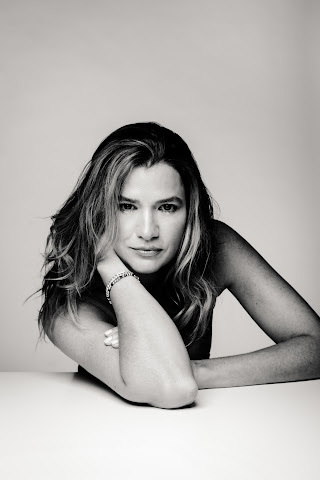 Christy Cashman
is anauthor, actress, and producer who has appeared in more than twenty films,including American Hustle, Joy, The Women, Ted 2, and The Forger, and whosescreenwriting credits include The Love Guru and Dixie Storms. An active memberof the Boston community and beyond, she is on the board of directors for theAssociates of the Boston Public Library and co-chairs its Literary Lightsdinner committee. Christy also serves on the board of the CommonwealthShakespeare Company and supports the nonprofit Raising A Reader.
Christy Cashman
is anauthor, actress, and producer who has appeared in more than twenty films,including American Hustle, Joy, The Women, Ted 2, and The Forger, and whosescreenwriting credits include The Love Guru and Dixie Storms. An active memberof the Boston community and beyond, she is on the board of directors for theAssociates of the Boston Public Library and co-chairs its Literary Lightsdinner committee. Christy also serves on the board of the CommonwealthShakespeare Company and supports the nonprofit Raising A Reader.Her book The Truth About Horses,which was published in August 2023, has garnered early acclaim in literarycircles and has captured the admiration of the equestrian community. It was anAmazon Bestseller and #1 new release. In addition to her successful debutnovel, Christy is also the creative mind behind two beloved children's books: The Not-So-Average Monkey of Kilkea Castle and Petri’s NextThings. These enchanting stories draw inspiration from the true tale of aheroic monkey residing in the historic Irish castle.
Christy, her husband, and their two sons, JayMichael and Quinn, live in Boston and spend time in Ireland and on Cape Cod.Christy has three dogs and three horses and is an avid equestrian, riding bothstateside and internationally, all year long.
She is currently working on her second novel,Beulah, and her third children’s book, The Cat Named Peanut Shrimp Cookie FryMuffin Who Lives on Staniel Cay.
1 - How did your first book change your life? Howdoes your most recent work compare to your previous? How does it feeldifferent?
Theprocess of writing The Truth About Horses has definitely changed my life. Inorder to write Reese’s character from an authentic point of view involved a lotof self discovery. Taking the time to delve into her character also involvedrealizing things about me that I either had never coped with or possibly copedwith in an unhealthy way. In some ways it gave me the opportunity to revisitmyself as a 14 year old, who was struggling with the state of being human. Insome ways I had to learn how I worked as a writer. I had to learn that whenthings got difficult in the process to write my way through it. I had to learnto dedicate time when sometimes I didn’t feel like I had any. Taking the timewas possibly the most important thing I’ve ever done for myself. I learned tobe proud of myself in a way that I have never been before. When I look back atsome of my work before The Truth About Horses it feels very ‘writerly’. Almostlike I was trying to write how I thought I should write as opposed to writing froman authentic place.
2 - How did you come to fiction first, as opposedto, say, poetry or non-fiction?
The partof the book that came to me first was the image of the wild horses. I wasn’teven sure what it represented, but I knew it was powerful. I knew I would weaveit into my story. I knew I wanted the story to be grounded in real feelings andtrue relationships, but I also wanted an element of magical realism which wasbest suited for fiction.
3 - How long does it take to start any particularwriting project? Does your writing initially come quickly, or is it a slowprocess? Do first drafts appear looking close to their final shape, or doesyour work come out of copious notes?
TheTruth About Horses took 9 years, but I was also putting it down for longperiods of time. Sometimes for months. But I did try to keep working onsomething. I wrote a couple of children's books, a couple of articles, Iconstantly journaled and even started a gratitude journal. But I had to learnmy process as I wrote. One of my favorite expressions is “I was building theplane while I was flying it.” It seems so appropriate because although I mayhave a natural ability for my craft, there were so many tools that I had tolearn along the way. Those tools are the things that sometimes were moreimportant to me than my natural ability. The ones that made me sit down towrite even when I didn’t feel like it, the ones that taught me to believe thatwriter's block is really just a reason to write more. I think the fact that Iwould take a break for months from my manuscript, pick it up again and beinspired and invigorated was a sign for me that the story was worth writing.And more importantly, worth finishing. I would say that there are large chunksof my original draft that were maintained through other drafts but structurewas something that I worked on all the way through revisions. And working onstructure in and of itself feels like it takes a whole other skillset. I’velearned that I am not necessarily a fast writer and I’ve learned that I’m okaywith that. Things seem to take a long time to cook for me. I think I’mrealizing that with time there’s a lot of added flavor.
4 - Where does a work of fiction usually beginfor you? Are you an author of short pieces that end up combining into a largerproject, or are you working on a "book" from the very beginning?
I amalways drawn to worlds first. If I can start to see a world and begin todescribe it then I know I can create believable characters to live in thatworld. Those characters will then have the rug jerked out beneath their feet,then forced to see their world anew. Worlds, whether they be a house, a barn, atown, or a hospital room are what make me tick as a writer. The sheerexcitement of understanding a world with all of its layers is often what makesme sit down to write. I very rarely work on short pieces. For some reason, Ienjoy the three act structure, with well developed characters and well-pacedplots.
5 - Are public readings part of or counter toyour creative process? Are you the sort of writer who enjoys doing readings?
Idefinitely enjoy doing readings. I know that it's fun for me to hear authorsread their own material, because I get an idea of exactly what the author wasthinking. I think public readings only enhance the experience of being anauthor. I think the whole dream of being a creative person is to one day shareyour work.
6 - Do you have any theoretical concerns behindyour writing? What kinds of questions are you trying to answer with your work?What do you even think the current questions are?
It’simpossible to be a creative person and not be full of self doubt. In some ways,it’s the self doubt that drives me. Therefore, there will always be questions.One big theme that I enjoyed writing about was recognizing how we can be livingour lives, being busy and doing everything that we think we should be doingwithout truly connecting. I was really influenced by the play Our Town by Thornton Wilder. My mom and dad took me to our local playhouse to see it. It wasimpossible to not incorporate some of the themes from that play into my novel.
7 – What do you see the current role of thewriter being in larger culture? Do they even have one? What do you think therole of the writer should be?
I thinkit’s the writer's job to entertain and provoke feeling. If I read something orwatch something or see an exhibit and it makes me feel something, possiblyunexpected, then the creator has done their job. The role of the writer is tomake us feel. End of story.
8 - Do you find the process of working with anoutside editor difficult or essential (or both)?
I had afantastic relationship with my editor, Louise Piantedosi. She was the perfecteditor for me because she was sensitive to all of the details and nuance of thestory. She even helped me to dive deeper into the characters, theirrelationships and the description of the horse related scenes. I felt likehaving Louise’s perspective was crucial for my book.
9 - What is the best piece of advice you've heard(not necessarily given to you directly)?
“When ascene pops into your head, you have to write it, even if it doesn’t end up inthe story.” I think the writing takes place in the subconscious, so much sothat when I found myself overthinking a scene it was usually a scene that I hadto scrap. I found that when a scene popped into my head out of nowhere, myfirst instinct was to dismiss it. The deeper I got in the process, the more Irealized how important it was to write every scene that popped into my headbecause that’s my subconscious trying to tell me something. It might just beinforming me of a feeling or a detail that I hadn’t thought of, but either waythe information was always necessary.
10 - How easy has it been for you to move betweengenres (children's books to the novel)? What do you see as the appeal?
Writingthe children’s books really started out as an exercise for me. While taking aclass, one of my instructors told me that writing children's books was a greattool to use. It helps to distill a story down to being able to tell the storyvery simply and not overcomplicate the themes. I found it extremely helpful andI would advise anyone writing a novel to try it. It’s a reminder that writingis supposed to come from a creative and fun place. Writing children's books isa great tool to bring the fun back into writing.
11 - What kind of writing routine do you tend tokeep, or do you even have one? How does a typical day (for you) begin?
Mywriting day depends on what stage I’m in with my story. In the beginning Iforced myself to take classes in order to be accountable. I knew myself wellenough that I knew if I wasn’t in a class, I wouldn’t take the time to write.In order to get a first draft, I took several years of different writingclasses. My goal was just to keep writing even if I wasn’t working on themanuscript in the classes. After I got a first draft, then I realized thathaving the eyes of an editor would be helpful because at that point I was tooclose to the canvas. During editing and revisions, I found that since the storywas there and mostly on paper, it was almost like I had to put on the hat of anarchitect in order to see the bones of the story and where the plot pointswere.
I writebest in the mornings, with my coffee before I’m swamped by texts and emails andlife. Whether it’s fifteen minutes or six hours, I feel best when I start myday with writing in the morning.
12 - When your writing gets stalled, where do youturn or return for (for lack of a better word) inspiration?
I walkmy dogs. Or take a trail ride on my horse. Nature is always an inspiration.
13 - What fragrance reminds you of home?
A skunk.They were always hit on the road outside my house.
14 - David W. McFadden once said that books comefrom books, but are there any other forms that influence your work, whethernature, music, science or visual art?
Inspirationcomes from so many different places. Definitely TedTalks, podcasts,documentaries, stories behind art exhibits, and museums for sure. For me musiccan be distracting unless it's a nondescript instrumental.
15 - What other writers or writings are importantfor your work, or simply your life outside of your work?
The mostinfluential books I’ve read for my writing, I probably read between the ages of12 and 15, Anne of Green Gables, the Narnia Tales, the Red Pony, Of Mice &Men to name a few. I also love almost all the lyrics from Cat Stevens. Later onin life, writing inspiration came from Dave Eggers, John Irving, Frank McCourt,Wally Lamb, Tom Perrotta, Olive Ann Burns and Gail Honeyman.
16 - What would you like to do that you haven'tyet done?
Write abook that becomes a series for an online streaming service. I would also liketo have a writing retreat in Africa as part of my mentorship program. Wouldalso love to take my family, dogs and horses to live off the grid for a while.
17 - If you could pick any other occupation toattempt, what would it be? Or, alternately, what do you think you would haveended up doing had you not been a writer?
Withouta doubt a veterinarian. I am very interested in holistic health for animals(and people). But I would probably practice on my husband and children.
18 - What made you write, as opposed to doingsomething else?
I wasvery frustrated with my experience in the film world, and as much as peoplelove the collaborative part, it was very difficult to have my voice andmaintain it when there were so many other ‘more important’ people vying forposition. Compared to the collaborative work that's done in the film world, Ienjoyed the lonely journey of writing a novel.
19 - What was the last great book you read? Whatwas the last great film?
The lastgreat book I read was called The Yellow House by Sarah M. Broom. I recentlywatched the tv series Love & Death on HBO, and I thought the acting wasincredible.
20 - What are you currently working on?
My nextnovel, Beaulah, is a novel that is set in the Smoky Mountains in Tennessee, ina fictitious town called Beaulah in the 1980’s. The main character is BarrettChildress Owens, and she goes to her high school one day to find one of thegirls in her class has gone missing. It sort of is about what happens when atown is gripped in fear. How hypocrisy creeps into friendships andrelationships and poisons them.
April 6, 2024
Rennie Ament, Mechanical Bull
HOW TO MAKE MILK
Coat the cow in calm.
Sing it a song
with blossoms. Where agirl
who smells like vinegar
sells violets. Pick
your version: make herdie or find
Wild mind by the side ofthe road.
Give her a lover.
They touch each other
like a goat and toddler
at the petting zoo.
Toddler calls the greatpony.
Goat could use astrawberry
to rub its head against.
 Ittook a while to get to, but I’m finally working my way through Maine poet Rennie Ament’s full-length debut,
Mechanical Bull
(Cleveland OH: ClevelandState University Poetry Center, 2023), a collection of short, sharp lyrics of slyhumour, observational oddness, language play and smooth clarity. For much ofthe collection, Ament’s poems offer a straightforward lyric of subtle turns, withechoes of what could be seen as correlations with those sly Canadiansurrealists Alice Burdick or Jaime Forsythe. “Someone told me, take a leftat the next light.” Ament writes, to open the poem ““PERFECPTION IS REALAND THE TRUTH IS NOT”,” “Her name was Imelda Marcos. She sat like a window / festooned in blue silk.Her son Bongbong still a baby boy / in the backseat. I swung / on asinstructed.” Elsewhere, Ament’s language play is more overt, allowing collisionsof sound and meaning as the spark of the poem emerges from and across thosebreaks. Listen, for example, to the poem “RENATA S AMENT,” a short poem on herown name that begins: “Me. / A name. / An enema / as atman. Tart / as a manatee’steat.” Ament’s poems offer a delightful sense of play but one still very sly, almostcovert, and provide effects slightly disorienting. “Remember me knee-deep.” thepoem “HE THEN PLEDGED” begins, “Remember me kelp-bedecked. / Remember me wet, /legs pretzeled, sex-melted /yet spleen-tempered.Best egg / esteem the verve, never / defer me.”
Ittook a while to get to, but I’m finally working my way through Maine poet Rennie Ament’s full-length debut,
Mechanical Bull
(Cleveland OH: ClevelandState University Poetry Center, 2023), a collection of short, sharp lyrics of slyhumour, observational oddness, language play and smooth clarity. For much ofthe collection, Ament’s poems offer a straightforward lyric of subtle turns, withechoes of what could be seen as correlations with those sly Canadiansurrealists Alice Burdick or Jaime Forsythe. “Someone told me, take a leftat the next light.” Ament writes, to open the poem ““PERFECPTION IS REALAND THE TRUTH IS NOT”,” “Her name was Imelda Marcos. She sat like a window / festooned in blue silk.Her son Bongbong still a baby boy / in the backseat. I swung / on asinstructed.” Elsewhere, Ament’s language play is more overt, allowing collisionsof sound and meaning as the spark of the poem emerges from and across thosebreaks. Listen, for example, to the poem “RENATA S AMENT,” a short poem on herown name that begins: “Me. / A name. / An enema / as atman. Tart / as a manatee’steat.” Ament’s poems offer a delightful sense of play but one still very sly, almostcovert, and provide effects slightly disorienting. “Remember me knee-deep.” thepoem “HE THEN PLEDGED” begins, “Remember me kelp-bedecked. / Remember me wet, /legs pretzeled, sex-melted /yet spleen-tempered.Best egg / esteem the verve, never / defer me.”Thesepoems really are delightful, thoughtful, and compact. The collection is structuredin two sections--halved, one might say—of short poems that play with a varietyof line-lengths and form, each offering their own variation on that centralcore of compact observation, but one slightly turned, twirled or twisted. “Motherand father were nude models.” she writes, to open the poem ““DISCLOSE THE SHADYLOCATION IN WHICH YOU LURK”,” “Neither of them ever hit me. Once // I bit mymother so she bopped me, / which is different. I had crossed the street //wrong.” What a lovely book. What a lovely debut.
April 5, 2024
Matt Rader, FINE: Poems
Last summer in Sunnybrae
we watched from acrossthe lake
a kilometre of railcars
the colour of oldmemoires
slowly describe theshoreline westbound
below Mount Tappen
What are they hauling? I asked,knowing
we didn’t have an answer
The insides of mountains,trees, prairie
I imagined
It was difficult to watch
something being taken
but what
exactly (“Sweet Air”)
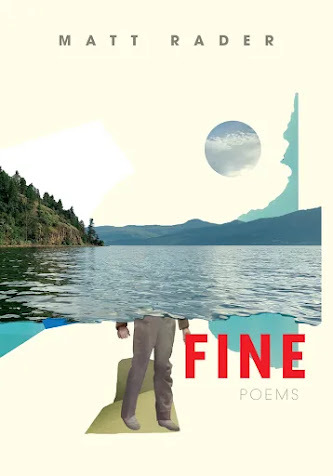 Thelatest from Kelowna, British Columbia writer Matt Rader is
FINE: Poems
(Nightwood Editions, 2024), a book of fire, climate and crisis, includingdeforestation, mining and other increasingly-devastating resource-extractions. Ashis author biography inside the collection reads, Rader is the “award-winning authorof six volumes of poetry, a collection of stories and a book of nonfiction,”the last title on that list being
Visual Inspection
(Gibsons BC: NightwoodEditions, 2019) [see my review of such here]. Composed across twenty momentsorganized in four cluster-sections (as well as a further poem, hidden aspost-script, just after the acknowledgments and author biography), the poems inFINE articulate “a vision of the present from a deep future, chartingthe porous borderlands of the self and the social through a year of cataclysm.”There might be those who don’t recall that particular year, existing within theCovid-era, of the British Columbia fires, and this collection exists as an intriguingcounterpoint to Delta, British Columbia poet Kim Trainor’s new long poem aroundthe same geography and subject matter,
A blueprint for survival: poems
(Toronto ON: Guernica Editions, 2024), a book I’ve yet to fully delve into.
Thelatest from Kelowna, British Columbia writer Matt Rader is
FINE: Poems
(Nightwood Editions, 2024), a book of fire, climate and crisis, includingdeforestation, mining and other increasingly-devastating resource-extractions. Ashis author biography inside the collection reads, Rader is the “award-winning authorof six volumes of poetry, a collection of stories and a book of nonfiction,”the last title on that list being
Visual Inspection
(Gibsons BC: NightwoodEditions, 2019) [see my review of such here]. Composed across twenty momentsorganized in four cluster-sections (as well as a further poem, hidden aspost-script, just after the acknowledgments and author biography), the poems inFINE articulate “a vision of the present from a deep future, chartingthe porous borderlands of the self and the social through a year of cataclysm.”There might be those who don’t recall that particular year, existing within theCovid-era, of the British Columbia fires, and this collection exists as an intriguingcounterpoint to Delta, British Columbia poet Kim Trainor’s new long poem aroundthe same geography and subject matter,
A blueprint for survival: poems
(Toronto ON: Guernica Editions, 2024), a book I’ve yet to fully delve into. Acrossthe poems of FINE, Rader offers long, meditative stretches, almost as asingle, meditative length, through this year of catastrophe, offering a thoughtful,quiet and slow-moving sketchwork of point-form, writing of visiting his brother’sfarm, watching the landscape hollowed out and the aftermath of a season oforange skies. As the poem “Working on My Brother’s Farm in Errington, BC”writes: “When we read / a silence / we change it. I can’t tell you / what it’slike / to be outside / language / inside language. The tall grass / at the edge/ of the field makes shapes / in the breeze [.]” These are poems that existfrom within a changing landscape, and one that sits nervously on a precipice ofcomplete environmental, entirely man-made, collapse. Throughout, Rader offerslovely sequences of sharp moments, turns and observations across a poem-suiteof sharp attention, deep concern and an abiding engagement with his landscape. Really,it is just as much the pacing of his short lines and line-breaks that makethese poems as any other element, moving at exactly the correct speed as itmakes its way down the page. As well, the ‘hidden track’ poem-as-postscript, “LiteReading,” offers its own kind of conclusion to the collection, opening: “Whatdoes a good future look like? / I asked the plum tree / as I steadied myself /on the aluminum stepladder. In its bare branches / the tree held open a fewchoice pages / of daylight to read. That’s what it asks here, I said / but theplum knew that passage / from memory / being a natural, as it were, in the literature/ of water and heat.”
April 4, 2024
12 or 20 (second series) questions with Jose Hernandez Diaz
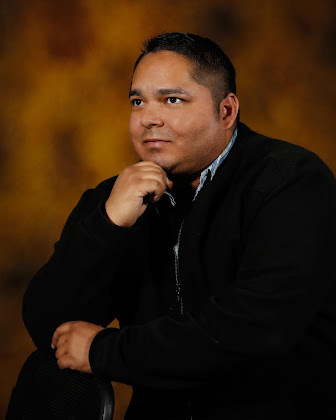 Jose Hernandez Diaz
is a 2017 NEA PoetryFellow. He is the author of
The Fire Eater
(Texas Review Press, 2020),
Bad Mexican, Bad American
(Acre Books, 2024), The Parachutist (SundressPublications, 2025) and Portrait of the Artist as a Brown Man (Red Hen Press,2025). He has been published in The American Poetry Review, The Yale Review,The London Magazine, Poetry Wales, The Iowa Review, Huizache, Círculo dePoesía, Periódico de Poesía, The Missouri Review, Epoch Magazine, The Nation,Poetry, The Progressive, Poets.org, The Southern Review, and in The BestAmerican Nonrequired Reading. He teaches generative workshops for Hugo House,Lighthouse Writers Workshops, The Writer's Center, and elsewhere. Additionally,he serves as a Poetry Mentor in The Adroit Journal Summer Mentorship Program.
Jose Hernandez Diaz
is a 2017 NEA PoetryFellow. He is the author of
The Fire Eater
(Texas Review Press, 2020),
Bad Mexican, Bad American
(Acre Books, 2024), The Parachutist (SundressPublications, 2025) and Portrait of the Artist as a Brown Man (Red Hen Press,2025). He has been published in The American Poetry Review, The Yale Review,The London Magazine, Poetry Wales, The Iowa Review, Huizache, Círculo dePoesía, Periódico de Poesía, The Missouri Review, Epoch Magazine, The Nation,Poetry, The Progressive, Poets.org, The Southern Review, and in The BestAmerican Nonrequired Reading. He teaches generative workshops for Hugo House,Lighthouse Writers Workshops, The Writer's Center, and elsewhere. Additionally,he serves as a Poetry Mentor in The Adroit Journal Summer Mentorship Program.2 - How did youcome to poetry first, as opposed to, say, fiction or non-fiction?
I actually started with short fictionin high school and undergrad. My last semester of undergrad I took a poetryworkshop with C. S. Giscombe. It was interesting but I was still very new topoetry. After I graduated with an English degree I didn’t know what I wanted todo. I started going to the public library where I discovered contemporary Poetsof Color. Octavio Paz. Marcus Wicker. Joy Harjo. Francisco X. Alarcon. Alurista. Victoria Chang. That’s when Irealized I could not only study poetry but write it as well.
4 - Where does apoem usually begin for you? Are you an author of short pieces that end upcombining into a larger project, or are you working on a "book" fromthe very beginning?
I usually start with a title or astriking image. I often like to write about iconic Mexican and Mexican Americanimagery or symbols like boxing, piñatas, sombreros, mariachis, jaguars, famlia,etc. Also, in my prose poetry, I tend to create characters and write frompersona and third person, like the Man in a Pink Floyd Shirt or the Man in a“Kafka for President” Shirt.
5 - Are publicreadings part of or counter to your creative process? Are you the sort ofwriter who enjoys doing readings?
I enjoy doing readings in moderation.Sometimes they can be surprising and thrilling. Sometimes they can bedisappointing and low turnout. Sometimes I have social anxiety. Sometimes Iembrace it and go with the flow. Oftentimes, though, I spend more time onwriting and reading and teaching than performing.
9 - What is thebest piece of advice you've heard (not necessarily given to you directly)?
“Don’t compare yourself to others.” Iheard Eduardo C. Corral tweet that before and I think it is solid advice.
10 - What kind ofwriting routine do you tend to keep, or do you even have one? How does atypical day (for you) begin?
Right now a lot of my writing hasbeen responding to prompts I create for my generative workshops.
11 - When yourwriting gets stalled, where do you turn or return for (for lack of a betterword) inspiration?
Prompts. Reading. Music. Space. Timeaway from writing.
Not looking for it. When it finds meit will come.
Maybe I need time away from it?
12 - What fragrancereminds you of home?
From childhood? Chlorine from thepool in the apartments I grew up in. From adolescence: pan dulce from thepanderia.
13 - David W.McFadden once said that books come from books, but are there any other formsthat influence your work, whether nature, music, science or visual art?
MF DOOM, Chicano Batman, Ramon Ayala,The Get Up Kids (music), the beach (nature), Philosophy (academics), Picasso,Kahlo, Rivera, ASCO, Jackson Pollock and Lee Krasner, Basquiat, my friends whowrote graffiti for DFLK, JPAK…
15 - What would youlike to do that you haven't yet done?
Teach full-time at an MFA Program,working with up and coming poets!
16 - If you couldpick any other occupation to attempt, what would it be? Or, alternately, whatdo you think you would have ended up doing had you not been a writer?
Maybe boxing or guitarist, not forbrutalist reasons, but I would’ve had to have started young.
18 - What was thelast great book you read? What was the last great film?
Instructions for the Soon-to-beBeheaded by Shivani Mehta. The Williams Sisters movie a couple years agobrought me to tears; inspirational.
19 - What are youcurrently working on?
Teaching workshops online. Readingsand interviews for Bad Mexican, Bad American. The Parachutist (SundressPublications, 2025); Portrait of the Artist as a Brown Man (Red Hen Press,2025).
April 3, 2024
new from above/ground press : Smith + Hall, eleftherion, Wren, Ebbitt, Deutch, Flemmer, Smith, carisse, Ballard, Burnham + The Peter F Yacht Club/VERSeFest Special,
 ; The Green Rose, in collaboration, Steven Ross Smith + Phil Hall $6 ; The Peter F Yacht Club #33/2024 VERSeFest Special, lovingly hand-crafted, folded, stapled, edited and carried around in bags of envelopes by rob mclennan $6 ; abject sutures, melissa eleftherion $5 ; From Desire Without Expectation, Jacob Wren $5 ; HYSTERICAL PREGNANCY, Katie Ebbitt $5 ; new york ironweed, Amanda Deutch $5 ; Alternate histories, Kyle Flemmer $5 ; Some Failed Eternity, Pete Smith $5 ; In The Margins. . . . . .of french translations found and remixed by russell carisse, russell carisse $5 ; BUSY SECRET, Micah Ballard $5 ; The Old Man: new stories, Clint Burnham $5 ;
; The Green Rose, in collaboration, Steven Ross Smith + Phil Hall $6 ; The Peter F Yacht Club #33/2024 VERSeFest Special, lovingly hand-crafted, folded, stapled, edited and carried around in bags of envelopes by rob mclennan $6 ; abject sutures, melissa eleftherion $5 ; From Desire Without Expectation, Jacob Wren $5 ; HYSTERICAL PREGNANCY, Katie Ebbitt $5 ; new york ironweed, Amanda Deutch $5 ; Alternate histories, Kyle Flemmer $5 ; Some Failed Eternity, Pete Smith $5 ; In The Margins. . . . . .of french translations found and remixed by russell carisse, russell carisse $5 ; BUSY SECRET, Micah Ballard $5 ; The Old Man: new stories, Clint Burnham $5 ; keep an eye on the above/ground press blog for author interviews, new writing, reviews, upcoming readings and tons of other material; see the previous batch of backlist from January-February 2024 here; and don't forget that Touch the Donkey [a small poetry journal] is still in the midst of a tenth anniversary sale!
published in Ottawa by above/ground press
February-March 2024
a/g subscribers receive a complimentary copy of each
and there's still time to subscribe for 2024! (easily backdated,
To order, send cheques (add $1 for postage; in US, add $2; outside North America, add $5) to: rob mclennan, 2423 Alta Vista Drive, Ottawa ON K1H 7M9. E-transfer or PayPal at at rob_mclennan (at) hotmail.com or the PayPal button (above). Scroll down here to see various backlist titles, or click on any of the extensive list of names on the sidebar (many, many things are still in print).
Review copies of any title (while supplies last) also available, upon request.
Forthcoming chapbooks by ryan fitzpatrick, Mckenzie Strath, Kacper Bartczak (trans. by Mark Tardi), John Levy, alex benedict, Helen Hajnoczky, Ryan Skrabalak, Hope Anderson, MAC Farrant, Julia Polyck-O'Neill, Sacha Archer, Dale Tracy, Saba Pakdel, Peter Myers, Terri Witek and David Phillips (among others, most likely); what else might 2024 bring?
April 2, 2024
Johanna Skibsrud, MEDIUM
“LET THEM SLICE OFF OURHEADS”
“Let them slice off ourheads in the desert,” I whispered.
“Let our eyes roll uptoward the heavens; let our bodies
turn to dust and be blownin four directions from our
bones.”
I packed two sandwichesand an extra pair of stockings—
took my brother along.
When my uncle found us inthe marketplace and
delivered us back home,my mother shook her fist,
then knelt and sobbedinto her sleeve.
We tend to imagine ourlives as though they are in
themselves a limit ratherthan a tool or simple accessory,
like a knocker on a door.
I used to weep over thepassion until my head ached and I
could no longer see.
My father’s father was aJew, condemned; my mother
desired nothing more thanto lead a quiet, Christian life.
I hear loud noises in my head,which make it hard to
write this down.
 Thelatest from Johanna Skibsrud [see her 2009 ’12 or 20 questions’ interview here],a writer who “divides her time between Tucson, Arizona, and Cape Breton, Nova Scotia”is the poetry collection
MEDIUM
(Toronto ON: Book*hug Press, 2024), acollection that “shares the lives and perspectives of women who – in theirroles as biological, physical, or spiritual mediums – have helped to shape thecourse of history.” The author of three previous collections of poetry, threenovels and three non-fiction titles, as she writes to open her “PREFACE”: “Thisproject began a decade ago, while I was pregnant with my first child. I keptthinking during that time, and afterward—through those first all-consumingyears of parenthood, two miscarriages, and the birth of my second child—about theways in which women have served as mediums throughout history, and of the waysthey continue to serve. I thought of and looked again for guidance from thepowerful women whose bodies, minds, and spirits have acted as conduits ofknowledge and intuition; as points of convergence for the past, present, andthe future; as concrete points of channeling and accessing a way forward—or sideways,or otherwise.”
Thelatest from Johanna Skibsrud [see her 2009 ’12 or 20 questions’ interview here],a writer who “divides her time between Tucson, Arizona, and Cape Breton, Nova Scotia”is the poetry collection
MEDIUM
(Toronto ON: Book*hug Press, 2024), acollection that “shares the lives and perspectives of women who – in theirroles as biological, physical, or spiritual mediums – have helped to shape thecourse of history.” The author of three previous collections of poetry, threenovels and three non-fiction titles, as she writes to open her “PREFACE”: “Thisproject began a decade ago, while I was pregnant with my first child. I keptthinking during that time, and afterward—through those first all-consumingyears of parenthood, two miscarriages, and the birth of my second child—about theways in which women have served as mediums throughout history, and of the waysthey continue to serve. I thought of and looked again for guidance from thepowerful women whose bodies, minds, and spirits have acted as conduits ofknowledge and intuition; as points of convergence for the past, present, andthe future; as concrete points of channeling and accessing a way forward—or sideways,or otherwise.” Thepoems that make up MEDIUM are carved and constructed in a kind oflayering, providing different elements across a book-length project almost as apolyphonic call-and-response. Skibsrub’s lyrics and asides offer a multitude ofvoices, structures and perspectives, from Helen of Troy to Anne Boleyn, MarieCurie to Roe vs. Wade, and Shakuntala Devi to Hypatia of Alexandria. The effectis almost choral, offering threads on and around multiple figures vilifiedacross history, reclaiming the stories, purpose and legacies of an array ofhistorical women. “We don’t know either Julian of Norwich’s real name or / whather life was like before she recorded her Revelations / of DivineLove—the first known book to be written by a / woman in the Englishlanguage,” Skibsrud writes, “in the 14th century. Some / suspect shewas a mother before taking her vows, and that / during the plague years she mayhave lost one or more chil- / dren.” Skibsrud writes akin to an anthology thatleans into theatrical script, as different characters, including the narrator,take their turns in the spotlight. As the poem “SOMETIMES, I TELL MY DAUGHTER,/ YOU MAY FEEL” begins:
“Sometimes,” I tell mydaughter, “you may feel
one thing so strongly itseems it’s the only true thing.”
“But then the feelingsplits into two, and you find
there are other truethings.”
She holds onto my handand doesn’t look up.
“It’s also possible, ofcourse, to feel more than one thing.
Or for a single feelingto break down steadily into other
feelings over time.”
She begins to cry.There’s nothing more I can do. There
are, after all, only avery few hours in the day; they, at
least, do not divideendlessly.
I turn. She reaches after—.
Thereis a curious call-and-response element Skibsrud that employs in her book-lengthstructure, offering poems with the occasional aside, akin to Greek chorus,providing further information and foundation to what it is she is slowlybuilding. The narratives and legacies that Skibsrud weaves together alongside thoseof her (presumably) own first-person domestic considerations, including conversationswith her daughter, utilize language to offer both warning and study, seeking toprovide perspectives on histories lost or set aside, and what lessons might begarnered from those stories. The effect of becoming a mother to a youngdaughter, as Skibsrud, through both preface and the poems themselves suggest, pushthrough a further examination of the legacies of women, and how too often thosewith something to offer have been ignored, pushed aside or silenced. I wonderif Skibsrud is aware of Gale Marie Thompson’s remarkable Helen Or My Hunger(Portland OR: YesYes Books, 2020) [see my review of such here], which focuses abook-length lyric gaze around Helen of Troy? Skibsrud’s aside to introduce thepoem “LET THEM SLICE OFF OUR HEADS” reads:
Teresa of Ávila(1515-1582) was a Spanish mystic, writer, religious reformer, and spiritualguide. Her paternal grandfather had been a marrano, or converted Jew, at onepoint condemned by the Inquisition for returning to his Jewish faith. But Teresawas born a Christian and a noblewoman—her father having purchased a knighthoodafter securing success in the wool trade. Teresa was introduced to mysticwritings and romance novels by her mother and, as a child, dreamed of runningaway to North Africa in order to martyr herself there. At the age of twenty,she entered a convent and, after struggling with doubt, achieved the powerfulconnection with God she desired. Her fellow nuns were sometimes obliged to siton her, or tie her down, in order to keep her ecstatic and sometimes painfulvisions from quite literally carrying her away.
March 31, 2024
12 or 20 (second series) questions with Brian Dedora
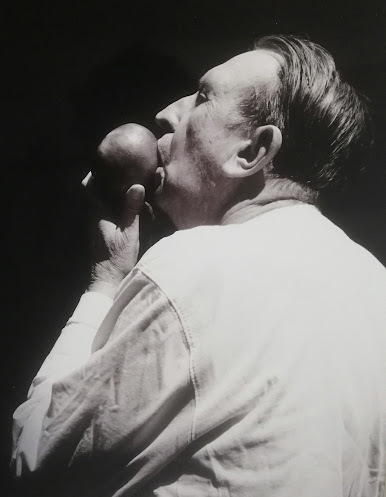
Brian Dedora’s novel/memoir A SLICE OF VOICE AT THE EDGE OFHEARING was a finalist for both the Relit Award and the George Ryga Prizefollowed by another “audacious experiment in narrative” A FEW SHARP STICKS,followed by LOT 351, and a book of his visual work from the 70’s and80’s entitled EYE WHERE, all books through the Mercury Press andTeksteditions. Editorial Visor in Madrid and BookThug in Toronto published hiswork on the Spanish poet and playwright, Federico Garcia Lorca, titled LORCATIONin a bilingual edition in 2015 along with TWO AT HIGH NOON published byVancouver’s Nomados Literary Press. BORDERBLUR and DIAGRAMS FOR A VAUDEVILLE OF POEMS published by NoiR:Z,Toronto, 2019. 2020 saw the publicationof PLAGUE SPOT and RECYCLED along with PHRASE-O-MATIC in2021 from NOiR:Z. Also in 2021, PAPER POEMS, Red Fox Press, Ireland, andin 2022 SECTION 2: Gap Riot Press, Toronto and POLAROID POEMS,Paper View Press, Portugal. Dedora lives and writes in Toronto where he honeshis skills in film photography with his vintage cameras.
How did yourfirst book or chapbook change your life? How does your most recent work compare to your previous? How does it feel different?
Yeah, axerox of a xerox expands the text...Oh, I thought, I could take that unfinishedpoem I wrote in creative writing class where the poem received a “You need toget your geography straight.” and a shitty ‘B- ‘... The poem could be redeemedbecause its visual along with corrections became, as a visual, a piece byitself. So, time to roll up my sleeves and get busy: xeroxing on a xerox ten times and reversingthe order so the most unreadable of the text appears first then moves to thebeginning of readability I then reduced the readable to the size of a postagestamp, so the entire piece laid out coalesces to almost total clarity and thenfades progressively to the reduced black shape of the poem. This became myfirst chapbook but also importantly my introduction to visual and concrete or “experimental”. I was not really interested in producing abook of discrete lyrical poems and producing this piece, THE DREAM, also brokea period of silence, a dry spell, of which I’ve had a few. Richard Truhlar and John Riddell ofPhenomenon Press wanted THE DREAM for distribution and published my secondchapbook a visual of breath diagrams, A POSTERIORI. Through them I met fellow writers also busywith experimental practices: Michael Dean, Steve Smith, bp, and the FourHorsemen. The lifelong importance of THE DREAM was to show me how I couldproduce in this vein which I’ve done my entire writing life. This was the wayto circumvent what I saw as puny poems with a tight return. My writing fromthat day forward was the beginning of a long trajectory where the visual andthe words became distinct pieces or distinctly separate but always undercuttingand circumventing the idea of the poem as I saw it. Word work has progressed from WHAT A CITY WASthrough some ten books to my latest piece THE APPLE IN THE ORCHARD all alongperfecting a technique of disruption in regards prose writing. The use ofincomplete sentences for the rapidity of thought, inclusion of visual materialsuch as photographs, bits of paper, and paintings. As to my latest work, THE APPLE IN THE ORCHARD, and how it compares to previous work is that it is the apex of myprose work so far in that it is both experimental and readable, not that theprevious books weren’t readable, but my technique has become so much betterbeing built through the experiments of previous work... each book spawnsanother in this long extension.
How did youcome to poetry first, as opposed to, say, fiction or non-fiction?
Thebedroom poems of my youth and the stuff I produced for my creative writingclass were junk and in the long run of no real interest. The problem was I hadn’t yet found my métier.
How long doesit take to start any particular writing project? Does your writing initially come quickly, oris it a slow process? Do first draftsappear looking close to their final shape, or does your work come out ofcopious notes?
My writingprojects, not counting the lightbulb flashes that produce visual work, are aslow process because they never start as a named project but arise from singlewritten pieces in a host of notebooks. When any piece typed out or now entered on my computer might begin a newproject as it sets off memories of other pieces resulting in a furious searchthrough several notebooks to find what I want and lay them beside what I’ve nowtyped or entered. One of the pieces nowused in THE APPLE, was written in 1991. Other notebooks and other pieces begin, as I remember them, in relationto what now seems “something”, no definition yet but a locus of interest.Time-wise the prose projects take up to five years, THE APPLE almost sevenwhich includes the pauses between entries. There’s a lot of just plain thought work which goes into each projectwhether book or chapbook... Oh, and the editing, the paring down.
Firstdrafts never look like the finished piece...never.
I don’twork from A to Z on any project it’s always a long typed out piece that afterrigorous scrutiny becomes a book.
Are publicreadings part of or counter to your creative process? Are you the sort of writer who enjoys doingreadings?
I enjoyreadings and I’m a good performer of my work but a half hour before I go on myguts are about to drop and I’m wondering why the eff do I do this... then it’sthe first breath and I’m on. The important thing to remember is you must giveback. There’s nothing worse than listening to an ego driven narcissist recite“pohems”. Why are poet voices in manycases so soft, so without inflexions, so far back in the throat...you must getout there to give your audience something to hear...Sheesh!!
Do you haveany theoretical concerns behind your writing? What kind of questions are you trying to answer with your work? What do you even think the current questionsare?
Idon’t have any theoretical concerns when I begin something... it’s acontemporary fixation as so much of writing is held and written withinacademia...all the better to rave on about it in class and it is a class thingwith an agenda. Remember PO-MO speak? What club do you belong to? Yikes, thatwas such a bore and a kind of mis-direction with a vocabulary to suit. You must recognize that between 1988 and 2008I did not write or publish so the whole “theoretical” kind of passed me by. Therewere some interesting thoughts/theories that grabbed hold especially thequestioning of the authorial absolute. I do enjoy reading theoretical essayswhich I forget quickly but the work is all there in some kind of punctum. Ifind that area of chaos or non-linearity especially fertile ground as evidencedby my three books, A SLICE OF VOICE AT THE EDGE OF HEARING, A FEW SHARPSTICKS, and most recently, THE APPLE IN THE ORCHARD. These books canbe read as long poems, collages, or “novels” all of them pushing against the university writing class prose read. Photography has also undergone huge shifts inits authority, meaning, and being. So, I don’t go out to shoot “theoretical”. Iget an idea and then shoot it. Thepandemic lockdown was really productive, I was shooting series every week. I make folders of these series some I’veshown many I haven’t.
What do yousee the current role of the writer being in larger culture? Do they even have one? What do you think the role of the writershould be?
The roleof the writer in the larger culture... that depends on how you’re getting paidand whose words you’re “employing”. Thechannels in which writing is read seem to me fairly limited where writers ofnecessity not only find it difficult to get published but even get heard. The proliferation of books and voices, thewhole global hum places the individual writer in solitary confinement whererelease is burrowing down into your own language and by whatever means gettingout there to speak to someone. It’s the “getting out there” that grinds theinitial impulse as so much gets in the way: the petty politics, the outrightcruelty, the narcissism in front of unremarkable work, the “give them what theywant” and the myriad agendas of all the demographics. Current questions...!!?? I don’t believe there is any over-arcingmoment where the great question can be asked because we don’t know it, Icertainly don’t. Where even, to open, toanswering. There are many demographicswhere you may never need to step out from, all with their own set of questionsand maybe their own answers. Theimportant thing is to show and teach that everyone can be creative in whateverform makes you burn. I was listening to a Zoom recently where Erín Moure spokeabout an essay by Chus Pato concerning thinking. It’s that type of essay of ideas that exciteme... the thing is I could read these essays and never get to work.
Do you findthe process of working with an outside editor difficult or essential (or both)?
Ilove working with an editor as I’ve only had two: Bev Duario and Stuart Ross.
WhenbpNichol and I did ABC Childhood we wrote a kind of call and response,
thenbp would type it, rip the finished piece out of the typewriter and beginimmediately inking out revisions where I’d be imploring, “Can we wait aminute?” The immediate revisions were away of getting or retaining initial impulse. Work with Bev Daurio was a treatas she would come on you very quietly with hints or suggestions which werebrilliant as she saw under what I’d written and then ask for a bit more. When Bev and I worked on A SLICE OF VOICEAT THE EDGE OF HEARING, she suggested taking one story/chapter andsplitting it in two and placing it separately in the book. It was a brilliantmove! Stuart was a very differenteditor as he worked for clarity without change to an original idea plus heenjoyed when I stood up for certain passages and then made suggestions of, “Canyou write three more of these passages?” I did write three more, The beloved buyer, in THE APPLE IN THEORCHARD. The point of working withthese editors is we all wanted the piece to be better and so we did.
What is thebest piece of advice you’ve heard (not necessarily given to you directly)?
“You’rethe artist, you’re the problem solver.” Jack Kidder, Victoria, B.C., 1969. The advice I got before leaving B.C. forToronto. I was Jack’s protégé and hetaught me about food, art, music, and buying my first piece of art, now lostI’m afraid, a clown in a frilly costume trying to fly with the bird that’sflying past... one must try!
How easy hasit been to move between genres (poetry to fiction to non-fiction to photographyto visual art)? What do you see as the appeal?
Movingbetween genres is a matter of keeping myself busy especially after I’vefinished a word event from WHAT A CITY WAS, 1983, to THE APPLE IN THEORCHARD, 2024. It’s the space when I am wordless and in between a wordpiece where I need to be busy, so I turn to visual work, whether collage, PLAGUESPOT, THE PAPER POEMS, and THE POLAROID POEMS or photography. The analogue photography with its mechanicalcameras ( I like the ‘feel’ of it working) is the same space that needs to be busy andfilled but in my camera work I shoot sequences mostly based on flash ideas:Eight photos of scrap paper found on Huron Street where I lived and whendeveloped I wrote out on the white scraps in the photos what I had done endingwith “beginning at my doorstep”, titled SCRAP NARRATIVE. You can, if youwish, go to YouTube, look up my name and READ THIS FOTO to see a recentexhibition from the 70s until now.
Theappeal... it’s fun but also a degree of fear as I set out to shoot an idea, atension that makes the work better. BoxSet and Bloonz, published by Viktlösheten Press are prime examplesof a flash idea which I shot and made a chapbook out of the results and sent itout where Viktlösheten agreed to publish it.
What kind ofwriting routine do you tend to keep, or do you even have one? How does a typical day (for you) begin?
I have nowriting routine until all the bits I’ve randomly written come together as onesomething, then it’s a more regular routine with lots of space to think aboutwhat more may be included i.e. new writing or a search through thenotebooks. I have wordless periodsespecially after a large project. Bylarge I mean a word event that is coalescing and becoming and when “done” I amkind of vacant.
When yourwriting gets stalled, where do you turn or return for (for lack of a betterword) inspiration?
Whenthe writing gets stalled, I turn to my heap of notebooks and read to findsomething. Read other writers bothpoetry and prose and essays especially Lisa Robertson or Erín Moure or anythingI might stumble upon or be told about.
Beeasy on myself. One day I need to typeout these notebooks.
What fragrancereminds you of home?
Freshbaked bread and flowers in the house.
David W.McFadden once said that books come from books, but are there any other formsthat influence your work, whether nature, music, science or visual art?
Fred Wahalso said books beget the next book not merely sequence but an impulse or the nexttechnical or maturing step. Ideas docome from various sources, mostly visual but also, importantly, light bulbmoments that are the quick writes that later form a whole or the flash bulbsfor a photography idea.
What otherwriters or writings are important for your work, or simply your life outside ofyour work?
What otherwriters or writings that are important...??!! Have you got time? I use otherwriters long after I’ve read them through some form of osmosis where I “hear”their voices and certain passages I write seem to have their voice: Faulkner,Burroughs, Goytisolo, Joyce, Modernists all but I’m still looking for acontemporary prose that really turns me on. For Canadian prose: Sheila Watson, John Riddell, Aaron Tucker. For Canadian poetry: bp, Steve McCaffery, Lola Tostevin, Kate Siklosi, Sonja Greckol, Dale Smith, Phil Hall, Erín Moure, Ralph Kolewe, Lisa Robertson, Kirby... How can I possibly name them all whetherdeep-dive or for singular events... near impossible.
Imust include my work on Federico Garcia Lorca as his life and writing were theinformatives to my book on Lorca titled, Lorcation, a tri-part bookcomposed of poems, an essay, and a reflective finale grounded in and on theland where Lorca was raised.
What would youlike to do that you haven’t done yet?
Writesomething completely straight.... nah! Some poetry, maybe...
Perhapscomplete a work that I’ve abandoned a few times and give it a kick in the butt.
If you couldpick any other occupation to attempt, what would it be? Or, alternately, what do you think you wouldhave ended up doing has you not been a writer?
I have hada life with two “careers” .... I becamea master gilder under the tutelage of the artist William Kurelek at the Isaacs Gallery and went into my own business to become one of the premier gildingpicture framers in the country. Alongside this I have followed my own creativelightbulb moments whether written or visual including a twenty-year dryspell...when I concentrated on building an art collection and writing about it.I am not making a financial life by writing, there is no imperative for me todo so. This privilege is a space Iworked my ass off to achieve: the time to follow those creative impulses tomake... yeah, that’s it... to make.
What was thelast great book you read? What was thelast great film.
Thelast “informative” books were Erín Moure’s, Theophylline, neck and neckwith Lisa Robertson’s, Boat, I just love being inside these books.
Thelast great film setting me out to a full-blown bawl: ALL OF US STRANGERS,
sixnominations at the BAFTA Awards and no win for a film whose narrative is notlinear
and,therefore, very upsetting for Fred and Mabel in Mississauga... fuck me...
Itends with Frankie Goes to Hollywood, THE POWER OF LOVE, tears drippingoff my chin and full-blown bawling.
Thebooks: after all the edits and with THE APPLE IN THE ORCHARD gone topress... six Rex Stout, Nero Wolfe mysteries .... yup!
What are youcurrently working on?
Currentproject is a resurrection of an older work that needs the ‘truth’ to get out ofthe way for the introduction of the chaos it needs: THOSE LOW HANGIN’ FRUITS... to becontinued...as I saw it one morning and how wide this piece could encompass andhow I might get there... I saw it whole, exciting and scary.
March 30, 2024
VERSeFest 2024 : a report from the ground,
 Our fourteenth annual poetry festival, VERSeFest: Ottawa's International Poetry Festival, happened last weekend, four venues across four nights, with more than two dozen poets [including Monty Reid, left, being introduced by Jennifer Baker], and was a resounding success, I don't mind saying. The festival got knocked around a bit across the Covid-era, so this is the first festival with myself as Artistic Director, with a brand-new board of directors for VERSe Ottawa, the organization that looks after the whole thing. And did you hear that three of our four nights held capacity crowds? Every night held incredible readings, without a low point across the board (although there were frustrations about accessibility across a venue or two).
Our fourteenth annual poetry festival, VERSeFest: Ottawa's International Poetry Festival, happened last weekend, four venues across four nights, with more than two dozen poets [including Monty Reid, left, being introduced by Jennifer Baker], and was a resounding success, I don't mind saying. The festival got knocked around a bit across the Covid-era, so this is the first festival with myself as Artistic Director, with a brand-new board of directors for VERSe Ottawa, the organization that looks after the whole thing. And did you hear that three of our four nights held capacity crowds? Every night held incredible readings, without a low point across the board (although there were frustrations about accessibility across a venue or two).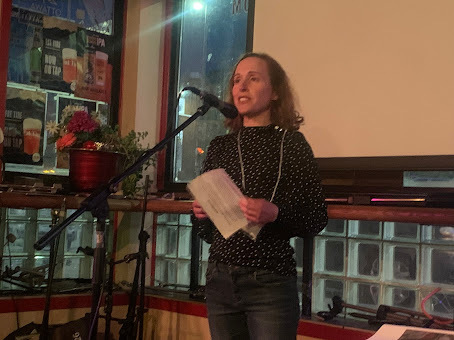 Thursday, March 21, 2024: Avant-Garde Bar, 7pm
Thursday, March 21, 2024: Avant-Garde Bar, 7pmAnita Lahey, Monty Reid, Marjorie Silverman, Laila Malik
hosted by Jennifer Baker / Arc Poetry Magazine,
Daniel Groleau Landry, nina jane drystek + MayaSpoken
hosted by Allison Armstrong
 Opening night held some strong readings, with returned-to-Ottawa poet Anita Lahey reading from her latest collection, offering an Ottawa poem or two. Ottawa poet Marjorie Silverman [above] not only offered a reading from her debut, and a Billings Bridge Mall poem, but her debut as a reader at VERSeFest! Laila Malik [left], another poetry and VERSeFest debut [see the recent interview here], startled the crowd with the strength of her reading (it is such a good book). And Monty Reid, longtime Artistic Director, anchored the whole first set with his own debut reading at VERSeFest (if you're staff or on the board you can't be scheduled, so we had to wait until he left, don't you know).
Opening night held some strong readings, with returned-to-Ottawa poet Anita Lahey reading from her latest collection, offering an Ottawa poem or two. Ottawa poet Marjorie Silverman [above] not only offered a reading from her debut, and a Billings Bridge Mall poem, but her debut as a reader at VERSeFest! Laila Malik [left], another poetry and VERSeFest debut [see the recent interview here], startled the crowd with the strength of her reading (it is such a good book). And Monty Reid, longtime Artistic Director, anchored the whole first set with his own debut reading at VERSeFest (if you're staff or on the board you can't be scheduled, so we had to wait until he left, don't you know). 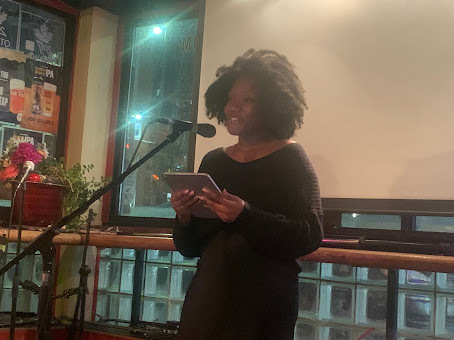 As part of the second set: it was good to hear new work from returning VERSeFest performer Daniel Groleau Landry; nine jane drystek did some very cool looped sound work (I know nina is shopping a full-length manuscript; once that is out, it is going to be incredible); and MayaSpoken is simply remarkable.
As part of the second set: it was good to hear new work from returning VERSeFest performer Daniel Groleau Landry; nine jane drystek did some very cool looped sound work (I know nina is shopping a full-length manuscript; once that is out, it is going to be incredible); and MayaSpoken is simply remarkable. 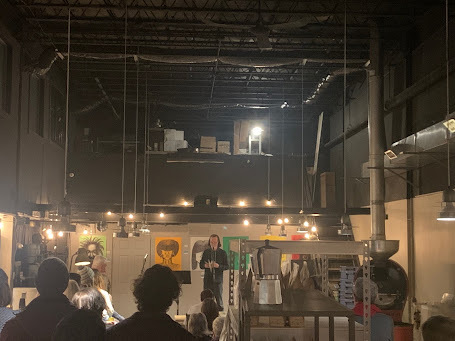 Friday, March 22, 2024 : Happy Goat, Laurel, door 7/reading 8pm
Friday, March 22, 2024 : Happy Goat, Laurel, door 7/reading 8pmAmanda Earl, DS Stymeist, IAN MARTIN, Mary Lee Bragg
hosted by Stephen Brockwell
Susan McMaster, Sneha Madhavan-Reese, Shane Rhodes
hosted by rob mclennan

Amanda Earl, of course, is a stellar reader, and her new book is grand. DS Stymeist [above], also read from a new book, and, akin to Monty Reid, was also debuting as a VERSeFest reader, having spent time as President of the VERSe Ottawa board (and thus, unable to read until after he stepped down). MaryLee Bragg read from her own newly-published book, but the highlight of the entire event (sorry, everyone else) had to be Ottawa poet IAN MARTIN [left] (yes, the upper case is deliberate), who really did provide surreal humour and a quiet, odd warmth through their set. You should be paying attention.
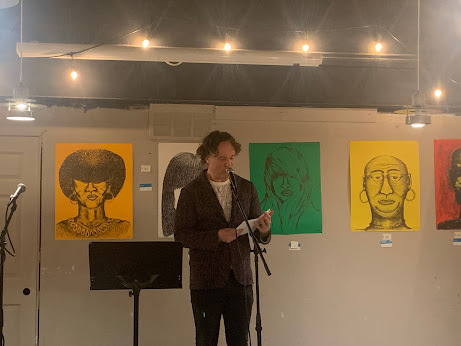 The second set held a reading by the very sparkly Ottawa poet Susan McMaster, who has a new book as well. Sneha Madhavan-Reese provided a sharp and curled straight-lined performance for her latest title (which I've been hearing some very good things about). Hopefully this isn't Shane Rhodes' [left] final Ottawa performance before he and his family move to Australia later on this year (you knew about that, didn't you?). I've really been enjoying his settler-work, playing off the novel (and subsequent film) that provided him his name. (Don't go, Shane! Shane, don't go!)
The second set held a reading by the very sparkly Ottawa poet Susan McMaster, who has a new book as well. Sneha Madhavan-Reese provided a sharp and curled straight-lined performance for her latest title (which I've been hearing some very good things about). Hopefully this isn't Shane Rhodes' [left] final Ottawa performance before he and his family move to Australia later on this year (you knew about that, didn't you?). I've really been enjoying his settler-work, playing off the novel (and subsequent film) that provided him his name. (Don't go, Shane! Shane, don't go!)
 Saturday, March 23, 2024 : Redbird, 8pm
Saturday, March 23, 2024 : Redbird, 8pmStephen Brockwell, Jaclyn Piudik, Chris Turnbull, Derek Webster
hosted by rob mclennan
Sandra Ridley, David O’Meara, Madeleine Stratford
hosted by Zishad Lak
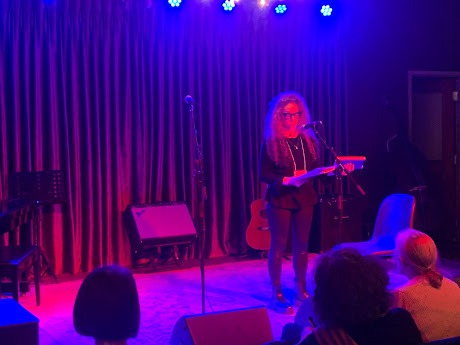 Board member (and Ottawa poet) Stephen Brockwell [above] provided a shorter set as last-minute fill-in, reading for Mark Goldstein, who wasn't able to make the event (he's doing fine, but just couldn't make it). Chris Turnbull [see the recent interview here] opened her reading, launching her latest book, with some poems by Phil Hall, to acknowledge the new book Goldstein edited and published, celebrating Hall and his work. It was interesting to hear Jaclyn Piudik [left] read, a poet I've only started reading lately. She has a new book as well, and made a point of opening with some poems by Mark Goldstein. And Derek Webster was just great. He read a poem that played off the work of Al Purdy. Who wouldn't love that?
Board member (and Ottawa poet) Stephen Brockwell [above] provided a shorter set as last-minute fill-in, reading for Mark Goldstein, who wasn't able to make the event (he's doing fine, but just couldn't make it). Chris Turnbull [see the recent interview here] opened her reading, launching her latest book, with some poems by Phil Hall, to acknowledge the new book Goldstein edited and published, celebrating Hall and his work. It was interesting to hear Jaclyn Piudik [left] read, a poet I've only started reading lately. She has a new book as well, and made a point of opening with some poems by Mark Goldstein. And Derek Webster was just great. He read a poem that played off the work of Al Purdy. Who wouldn't love that? Sandra Ridley [left; see the recent interview here], launching her latest from Bookhug Press, was her usual evocative, coiled calm, enough to quiet any room. Working in both English and French (as well as translation, Madeleine Stratford's performance had a liveliness and humour across hushed tones. And Ottawa poet David O'Meara, another former VERSeFest Artistic Director (before Monty), reading a handful of new poems, was the anchor that held all in place.
Sandra Ridley [left; see the recent interview here], launching her latest from Bookhug Press, was her usual evocative, coiled calm, enough to quiet any room. Working in both English and French (as well as translation, Madeleine Stratford's performance had a liveliness and humour across hushed tones. And Ottawa poet David O'Meara, another former VERSeFest Artistic Director (before Monty), reading a handful of new poems, was the anchor that held all in place. Sunday, March 24, 2024: Spark Beer, door 7pm/8pm
Sunday, March 24, 2024: Spark Beer, door 7pm/8pmAJ Dolman, Myriam Legault-Beauregard, Nduka Otiono,
hosted by Madeleine Stratford
Rhonda Douglas, Jason Christie, Klara du Plessis + Khashayar “Kess” Mohammadi,
hosted by rob mclennan
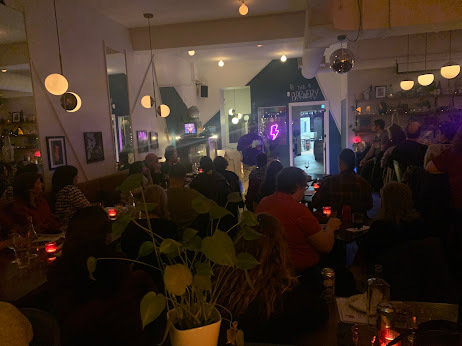 Our closing night! It was great to hear Ottawa poet AJ Dolman [above; see the recent interview here] launching their long-awaited debut full-length collection, a box of which landed in just enough time to catch our event (there will be a proper, full launch coming up). And great to hear poet and Carleton University prof Nduka Otiono [left] for the first time! He had a critical selected poems not long back from Wilfrid Laurier University Press that was quite interesting. And lovely to catch a reading blending English and French from poet Myriam Legault-Beauregard from her new book, already leaning into a second printing!
Our closing night! It was great to hear Ottawa poet AJ Dolman [above; see the recent interview here] launching their long-awaited debut full-length collection, a box of which landed in just enough time to catch our event (there will be a proper, full launch coming up). And great to hear poet and Carleton University prof Nduka Otiono [left] for the first time! He had a critical selected poems not long back from Wilfrid Laurier University Press that was quite interesting. And lovely to catch a reading blending English and French from poet Myriam Legault-Beauregard from her new book, already leaning into a second printing! Rhonda Douglas was good enough to provide a short opener of new poems (and curious for me to realize I've known her longer than I've known anyone else around here, having participated in a poetry workshop at the University of Ottawa alongside her and Joseph Dandurand, among others, during 1992-3). It was very nice to celebrate Ottawa poet Jason Christie's [left; see the recent interview here] last fall bpNichol Chapbook Award win through his reading, both from the award-winning chapbook as well as through a handful of new poems. I would think he's but the second Ottawa-based bpNichol winner, after Chuqiao Yang (I presume we'll have more, soon enough). And then, Montreal-based Klara du Plessis [see the recent interview here] and Toronto-based Khashayar "Kess" Mohammadi [see the recent interview here] closed out the event, and the festival, through a stellar collaborative set, which included their own individual works, as well as them reading from their recently-published book-length collaboration. There's an incredible amount of activity going on with those two, both individually and combined, that is worth paying attention to. Wow.
Rhonda Douglas was good enough to provide a short opener of new poems (and curious for me to realize I've known her longer than I've known anyone else around here, having participated in a poetry workshop at the University of Ottawa alongside her and Joseph Dandurand, among others, during 1992-3). It was very nice to celebrate Ottawa poet Jason Christie's [left; see the recent interview here] last fall bpNichol Chapbook Award win through his reading, both from the award-winning chapbook as well as through a handful of new poems. I would think he's but the second Ottawa-based bpNichol winner, after Chuqiao Yang (I presume we'll have more, soon enough). And then, Montreal-based Klara du Plessis [see the recent interview here] and Toronto-based Khashayar "Kess" Mohammadi [see the recent interview here] closed out the event, and the festival, through a stellar collaborative set, which included their own individual works, as well as them reading from their recently-published book-length collaboration. There's an incredible amount of activity going on with those two, both individually and combined, that is worth paying attention to. Wow.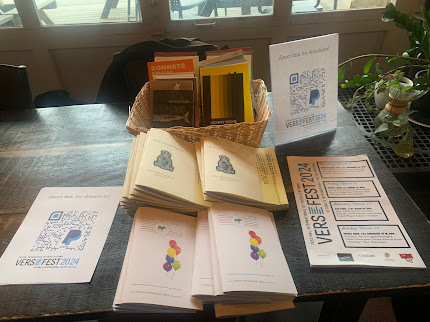 You probably also saw the new issue of The Peter F Yacht Club that was launched as part of the festival, holding poems by numerous of our readers and performers? I also had copies of the soon-to-release tenth anniversary issue of
Touch the Donkey [a small poetry journal]
, given there were poems within by Amanda Earl and Conyer Clayton. We also had a basket of books leftover from our fundraiser, offering for the sake of donations (although it took two days, unfortunately, to discover that the QR codes we printed didn't actually work).
You probably also saw the new issue of The Peter F Yacht Club that was launched as part of the festival, holding poems by numerous of our readers and performers? I also had copies of the soon-to-release tenth anniversary issue of
Touch the Donkey [a small poetry journal]
, given there were poems within by Amanda Earl and Conyer Clayton. We also had a basket of books leftover from our fundraiser, offering for the sake of donations (although it took two days, unfortunately, to discover that the QR codes we printed didn't actually work).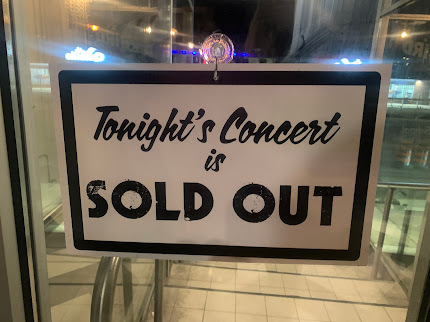 Given our hugely successful fundraiser, it didn't seem right to ticket all of the events, so three of our four nights were unticketed (honestly, so much of the fundraiser, whether time, books, chapbooks or cash came from at least half that crowd), but there were plenty of folk donating, still, across those four days, which is hugely appreciated by everyone on the board. Thank you so much to The City of Ottawa, Arc Poetry Magazine and The League of Canadian Poets for their ongoing support, and to Spark Beer, RedBird [left], The Happy Goat and Avant-Garde Bar for allowing us the use of their spaces. As many of you know, events such as these don’t occur in a vacuum, and I must thank the help of our current VERSe Ottawa board: Allison Armstrong, Frances Boyle, Stephen Brockwell, Éric Charlebois, David Currie (who really went above and beyond across the course of this entire thing, so thank you) and Zishad Lak for their ongoing and essential work. And Helen Robertson, who ran our book table! Helen is a delight. Of course, an essential thank you to outgoing director Avonlea Fotheringham for keeping the festival alive across the Covid Era, and Rod Pederson, who began this festival in the first place.
Given our hugely successful fundraiser, it didn't seem right to ticket all of the events, so three of our four nights were unticketed (honestly, so much of the fundraiser, whether time, books, chapbooks or cash came from at least half that crowd), but there were plenty of folk donating, still, across those four days, which is hugely appreciated by everyone on the board. Thank you so much to The City of Ottawa, Arc Poetry Magazine and The League of Canadian Poets for their ongoing support, and to Spark Beer, RedBird [left], The Happy Goat and Avant-Garde Bar for allowing us the use of their spaces. As many of you know, events such as these don’t occur in a vacuum, and I must thank the help of our current VERSe Ottawa board: Allison Armstrong, Frances Boyle, Stephen Brockwell, Éric Charlebois, David Currie (who really went above and beyond across the course of this entire thing, so thank you) and Zishad Lak for their ongoing and essential work. And Helen Robertson, who ran our book table! Helen is a delight. Of course, an essential thank you to outgoing director Avonlea Fotheringham for keeping the festival alive across the Covid Era, and Rod Pederson, who began this festival in the first place.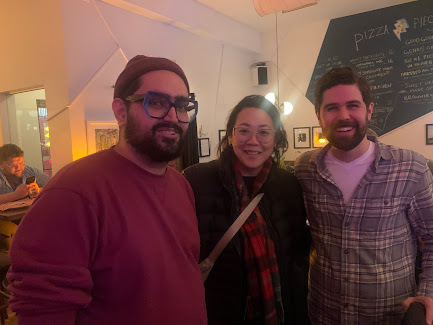 [left: Khashayar "Kess" Mohammadi, Chuqiao Yang + Cameron Anstee mid-break, Closing Night] With our rebuilding year, this was a smaller and more Ottawa-localized festival than prior years (unable to cover hotels and travel, for example), so we are hoping to do another version of this in the fall ("fall into versefest," or something akin to that), as well as hopefully announce our next round of poets laureate at the same time. With luck, we can return next spring with a fully-rebuilt festival! And in case you are wishing to donate, you can catch the donate page on our website. Maybe we'll see you at our next event! Otherwise, you know you should be checking out www.bywords.ca for all Ottawa-area literary events, yes? Monthly calendar! New poems!
[left: Khashayar "Kess" Mohammadi, Chuqiao Yang + Cameron Anstee mid-break, Closing Night] With our rebuilding year, this was a smaller and more Ottawa-localized festival than prior years (unable to cover hotels and travel, for example), so we are hoping to do another version of this in the fall ("fall into versefest," or something akin to that), as well as hopefully announce our next round of poets laureate at the same time. With luck, we can return next spring with a fully-rebuilt festival! And in case you are wishing to donate, you can catch the donate page on our website. Maybe we'll see you at our next event! Otherwise, you know you should be checking out www.bywords.ca for all Ottawa-area literary events, yes? Monthly calendar! New poems!


